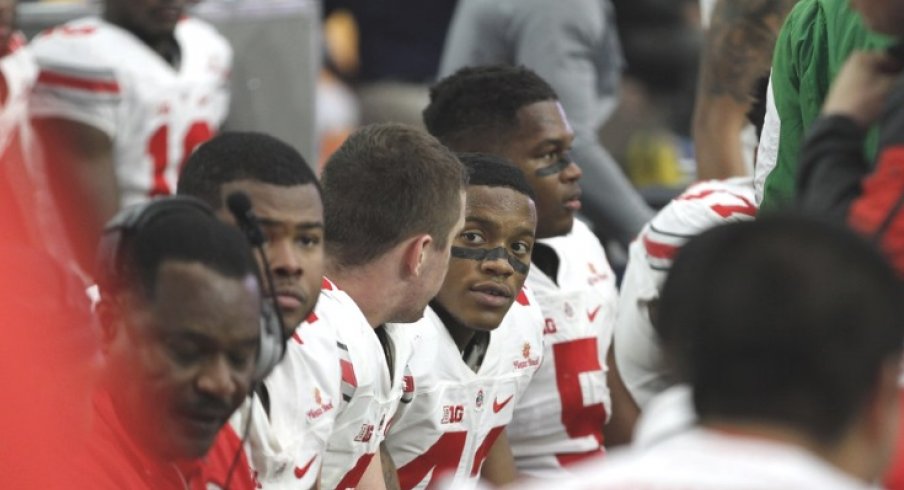In the Year of Our Lord 2019, the Ohio State Buckeyes will have two bye weeks.
That, my friends, is dumb.
Taking a quick look at the schedule, Ryan Day and company will be chilling, illing, and possibly doing some backyard grilling on October 12th and November 2nd (and in between that, will face Northwestern on Friday, October 18th for some reason). That's three beautiful autumn Saturdays in which Ohio State will be doing precisely jack and squat.
Which is great if you like apple picking and various chilly weather activities that involve checking for ticks. I can't deny the allure of both eating a potentially deadly amount of apples in one sitting, trying to patent a cider and popcorn based cologne, and pretending that I'm still young enough to be able to participate in pumpkin patch hayrides without seeming extremely weird; these are time-tested Ohio-in-Fall outdoor activities that make the other 49.5 weeks of ridiculously gross weather semi-worth it.
But life is about choices, and this article is about how college football in general is trying to reject the concept of scarcity.
See, time is finite. Well, our time is finite, at least. What's frustrating is that over the past decade it feels like college football and the experience of following the Ohio State Buckeyes is a commodity that has been and will continue to be stretched to its limits in brazen defiance of time and space.
I'll concede that bye weeks are nothing new. My first football season as an undergrad at OSU in 2003 included a bye right before a Wisconsin game that they lost in extremely irritating fashion, a few years later there was another bye before another loss by the same exact score (to Penn State this time), and of course in 2004 there was a bye week that preceded a three game losing streak that included an overtime loss to Northwestern.
So maybe I've been a little traumatized by any break in the Ohio State football action.
That'd be a fair take. I'm also a little concerned with bloat.
In 2007, for instance, the Michigan game was played on a ridiculously early November 17th, and the Buckeyes, having won that game, didn't play in the national championship against LSU until January 2nd. That's silly, and as the Big Ten expanded and added a championship game of its own, the rest of the college football world was making moves to figure out what to do with the potentiality of having that bigass gap.
Their solution was more byes, more games against scrub teams, and extending the season. No team had ever won 14 games until Ohio State did it in the 2002 championship season; Clemson just became the first to win 15. Which is fine, in theory! The back half of the college football season has been improved dramatically by adding championship games, decreasing the time between the conference season and bowls, and adding the playoff. The issue is that the front half of the season mostly has remained unchanged since in the last 20 years, and increasing bye weeks are a symptom of that lack of a desire to change.
Because the truth is that there's no reason for the Ohio States of the world to be playing the Florida Atlantics of that same world. As college football expanded the back end of its schedule, it should've also focused on cleaning up the front end. If starting the season later in September was the price that had to be paid for eliminating both useless games against bad opponents and bye weeks where little is accomplished, then so be it.
There are some arguments to be made in favor of the current system: "any football is good football" (this is absolutely false), "players need bye weeks to recover from injury and strain" (eliminating two games from the schedule would do more for player safety than giving them extra time to recover from said games), and "sometimes it's just fun to chill."

Okay Kevin and Dan, I get that! There are some decent enough games during Ohio State's non-playing weekends during the 2019 season, including Oklahoma against Texas, Michigan versus Penn State, and Georgia taking on Florida. There's also an assload of just utter crap, which takes us back to the original point.
I won't lie and say that I'm not looking forward to enjoying some relatively stress-free weekends during the best month on the Ohio calendar, but I would also like to be able to enjoy a college football season that isn't perpetually expanding and adding filler. Bye weeks are an indicator of a scheduling regime that values creating a 21 week block of endless programming over something shorter and more entertaining.
As media contracts have grown, conferences have sought to justify the hundreds of millions of dollars being spent to broadcast games. Since "quality" is a nebulous concept to television executives and can't really be quantified, they choose to focus on sheer numbers of games and time slots that can be filled.
As a result, Ohio State football will be used like the commodity that it is, and increasingly that will mean sitting on the shelf until the games that it does play can be optimized for maximum financial impact.
And those (like me) who are hoping for a tighter, more dramatic and meaningful season might finally have time to work on that elaborate pumpkin sculpture of Washington Crossing the Delaware they've been planning.


